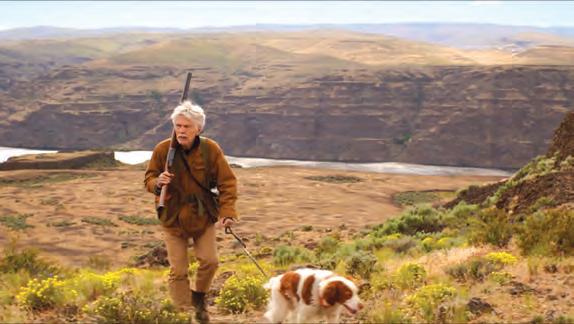
5 minute read
The District Vet: Cats and Aggression by Dan Teich
/ The District Vet /
CATS AND AGGRESSION
After house-soiling, aggression is the attack? What happened for the thirty minutes be- its human, it may swat, chase, nip, and show predsecond most common behavior- fore the incident? Where did it happen? These an- atory behaviors. Such behavior should not be enal issue we see in cats. Aggression swers will help you prevent future incidents. couraged, especially encouraging cats to chase peoin cats is not taken as seriously as Aggression usually does not happen out of the ples’ hands and feet. Cats also play rough when they in dogs, probably because cats are blue: your cat has a reason. There is a purpose to the have been inactive for long periods of time. We may smaller and people simply dismiss their behavior e ort. The most common type is cat-to-cat aggres- think cats are solitary creatures and don’t mind beas being normal for a cat or that the cat is simply sion. Unneutered male cats will have aggression to- ing home for extended periods, but they too require grumpy that day. This is a big mistake —cat bites and ward others as they stake out their territory. But ag- social interaction to have healthy behaviors. A tired claws can in ict serious harm to their people and gression between members of a household can be cat is usually a good cat. other cats, leading to infections and even hospital- more complicated. The instigating cat will posture, Redirected aggression can be the most dangerization. Key to preventing aggression is understand- while the other cat will make itself look smaller. The ous form of cat aggression as the behavior is uning the types of feline aggression, their triggers, and reasons for household members to have a dust-up inhibited and can result in serious bites and injusome measures to prevent this unwanted behavior. can include size di erences, territory claims, redi- ries. This behavior occurs when a cat is agitated or
First, what does cat aggression look like and rected aggression (see below), lack of feline social- scared by another cat, animal or person, that it canhow is it di erent than playing? It is not as easy to ization, resource guarding, and more. not reach. The cat will turn to the person or animal divine a cat’s intentions as a dog, but body posture Cats will posture and display aggressive-type nearby and viciously attack them. The most comand facial expressions are a good start. Aggression behaviors when they are frightened or threatened. mon scenario is a cat watching another cat through can either be o ensive or defensive—with both be- This makes sense—they pu up and defend them- a window or a screen door. It can also occur when ing equally dangerous. An o ensive posturing cat selves. They usually assume a more defensive pos- the cat is frightened, smells another cat on a person, will usually have a direct stare, erect ears, straight- ture, but may become more aggressive should the stalking another animal, or if a person tries to break legged upright stance, directly face the opponent, cat not be able to avoid that which is making it fear- up a cat ght. The time between the inciting cause and frequently growl. The pupils may also be small. ful in the rst place. Things which may make a cat and the incident can be hours, although it is freWhereas defensive behavior includes eyes wide fearful can include strange people, new objects, un- quently closely connected to the time of the cause. open, a crouched position with the head tucked in, usual smells, being startled, loud noises. If this be- The attack usually occurs if the person approachears attened, hair raised on the back, turning side- havior is seen, back away and give the cat space. es the cat—this cat does not seek out someone to ways, hissing or spitting, and possibly striking with ways, hissing or spitting, and possibly striking with If possible, eliminate the inciting cause. The cat If possible, eliminate the inciting cause. The cat attack. The behavior can be thought of as a re ex. front paws, claws out. front paws, claws out. should calm down. should calm down. This is why you should leave an agitated cat alone
Why is the cat showing aggression in the rst Why is the cat showing aggression in the rst Rough play can lead to Rough play can lead to and also not break up cat ghts. place? First is the cat healthy? Medical problems place? First is the cat healthy? Medical problems aggressive behaviors. aggressive behaviors. The last type we will address is petting-insuch as hyperthyroidism, dental pain, arthritis, such as hyperthyroidism, dental pain, arthritis, Kittens and younger Kittens and younger duced aggression. Some cats like to be stroked, painful areas and infectious diseases, includpainful areas and infectious diseases, includ- cats play in order to cats play in order to others don’t. The cat may tolerate it for a while, ing toxoplasmosis, can increase aggresing toxoplasmosis, can increase aggres- learn behaviors eslearn behaviors es- but then they are quite suddenly irritated and will sive behavior. If given the medical sive behavior. If given the medical sential for survivsential for surviv- let you know. To them, it may become annoying, all-clear, carefully observe your all-clear, carefully observe your al. The cats learn al. The cats learn or static may build up in their fur. Whatever it is, cat’s behavior. Can you cat’s behavior. Can you to not hurt each to not hurt each your cat wants you to stop. And you should respect gure out what made gure out what made other when playother when play- their wishes. her upset in the her upset in the ing, but this ining, but this in- Cats generally do not display aggression withfirst place? first place? hibition may not hibition may not out a reason. Discerning the cause may help you Who did Who did be present in cats be present in cats and your cat live a more peaceable coexistence. Lisshe she weaned young or weaned young or ten to your cat. raised by themraised by themselves. Therefore selves. Therefore when the cat plays with when the cat plays with

by Dan Teich, DVM
Dan Teich, DVM is Medical Director at District Veterinary Hospital Eastern Market. ◆











